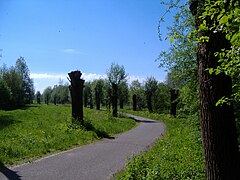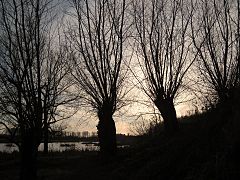Pollarded willow
A pollarded willow is a willow whose trunk was shortened as a young tree to a height of about 1 to 3 meters and whose branches are then regularly pruned.
General
The species used for this are mostly the silver willow ( Salix alba ) or the basket willow ( Salix viminalis ). The treated tree sprouts large numbers of new shoots at the cut surface. These rods are easy to reach and can be cut ( sniffed ) for economic use . Over time, the top section of the trunk thickens; the repeated head cut creates the head of the willow. Once a willow has been cut into a pollarded willow, it must be tended regularly. A cut is necessary every three to ten years, the period depends on the desired use, rods for braiding are cut at short intervals, for use as posts or stems there is a longer wait. Even an interval that is a few years longer (15 to 20 years) and the tree, with its statics changed by large branches , can partially break apart under their load (see also: dead wood ). This effect explains the large number of bizarre, damaged pollarded willows, whose vitality can compensate for such great damage for a long time to come.
As willow branches were often used as stakes for erecting pasture fences in the past, the enormous regenerative capacity of willow trees resulted in new plants. For this reason, pollarded willows are often in a row (e.g. on the Lower Rhine ). A modern form of grazing use is the life materials , this living branches are used for the construction of buildings. The possibilities of use range from the fastening of slopes by rooting the branches to considerable buildings made of living wood (such as a willow dome ). For use as a fascine , both live and already dried rods can be used. On the one hand, dead material provides a high level of resilience, but the sprouting, living rods with their roots secure the earth masses much more effectively. However, the resulting willow field is not desired everywhere.
The rods obtained were used in earlier times for basket weaving (basket willow) or in connection with clay as building material for house walls. Older or overgrown branches were used to make broom and tool handles.
Today there is hardly any economic use of pastures, since industrial substitute products have established themselves; accordingly, pollarded willows are only rarely cared for today (as of 2006). If maintenance is still carried out nowadays, it is mostly done by nature conservation organizations, which are committed to the preservation of the pollarded willows as a habitat for numerous animal species, especially the bats and owls, which are threatened in their population . These animals find shelter and nesting opportunities in the often hollow trunks. Both the male and the female pastures with their kittens provide the bees with their first food in spring. That is why not all willows in a stand are cut in one year, but only individual ones alternately.
Pollard willows are characteristic for the appearance of the Lower Rhine region .
The Lower Rhine district of Wesel and the Swiss municipality of Widnau have a pollarded willow in their coat of arms, while that of the municipality of Lambrechtshagen shows two trees of this type.
Pollarded willow in the Siegaue before pruning, February 2015
Pollard willows after the snowing , Berlin, Britzer Garten , March 2018
A rare cobbled avenue near Wittislingen
See also
literature
- Erich Staudt: Pollard willows: Origin - Use - Care. 2nd edition, Mercator, Duisburg 1991, ISBN 3-87463-147-8 .
- Bettina Braun, Werner Konold: Pollarded willows: cultural history and meaning of pollarded willows in southwest Germany. Regional culture publishing house, Ubstadt-Weiher 1998, ISBN 3-929366-30-4 .
- Andrea Dohmann, Ulrich Kaminsky: Das Kopfweiden-Handbuch: A practical guide for educational work. Regional Verlag Kiper, Bielefeld 2005, ISBN 3-936359-13-X .
Movie
- Habitat head tree. The sustainable benefits of pruning. (OT: Trognes, les arbres aux mille visages. ) Documentary film, France, 2017, 51:35 min., Script and direction: Timothée Janssen, production: Camera Lucida Productions, arte France, first broadcast: June 8, 2018 by arte, summary from ARD , online video.
Web links
Individual evidence
- ^ Polluted willows (NABU Brandenburg-Havel) ( Memento from September 30, 2007 in the Internet Archive )






